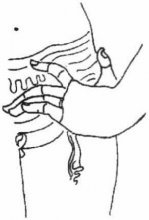Katyalambana, Kaṭyālambana, Kati-alambana: 1 definition
Introduction:
Katyalambana means something in Hinduism, Sanskrit. If you want to know the exact meaning, history, etymology or English translation of this term then check out the descriptions on this page. Add your comment or reference to a book if you want to contribute to this summary article.
Images (photo gallery)
In Hinduism
Shilpashastra (iconography)
Source: Shodhganga: Vaisnava Agamas And Visnu ImagesKaṭyālambana (कट्यालम्बन) is another name for Kaṭihasta: one of the various hand-poses (hastas or mudrās) defined in treatises such as the Pāñcarātra, Pādmasaṃhitā and Vaikhānasa-āgamas, extensively dealing with the technical features of temple art, iconography and architecture in Vaishnavism.—Kaṭihasta is generally known as kaṭiga, kaṭistha, kaṭisaṃsthita, kaṭyālambana and kaṭyavalambita. The hand remains bent a Little at the elbow and placed on the upper part of the waist. This gesture is generally found on the lower left hand. Pādmasaṃhitā (Kriyāpāda 20.81b) prescribes, while holding gadā; the hand should be two aṅgulas away from the hip of the icon. According to Nāradīyasaṃhitā, the palm of the hand holding gadā must be to the level of kaṭisūtra. In the absence of gadā, the hand remains touching the hip or it may be kaṭyālambana. The kaṭivastra touching the hip in the movable icon (jaṅgama-arcā) is specially meant for mundane (aihika) results.

Shilpashastra (शिल्पशास्त्र, śilpaśāstra) represents the ancient Indian science (shastra) of creative arts (shilpa) such as sculpture, iconography and painting. Closely related to Vastushastra (architecture), they often share the same literature.
See also (Relevant definitions)
Partial matches: Alambana, Kati.
Full-text: Katihasta, Katistha, Katiga, Katisamsthita, Katyavalambita.
Relevant text
No search results for Katyalambana, Kaṭyālambana, Kati-alambana, Kaṭi-ālambana; (plurals include: Katyalambanas, Kaṭyālambanas, alambanas, ālambanas) in any book or story.
